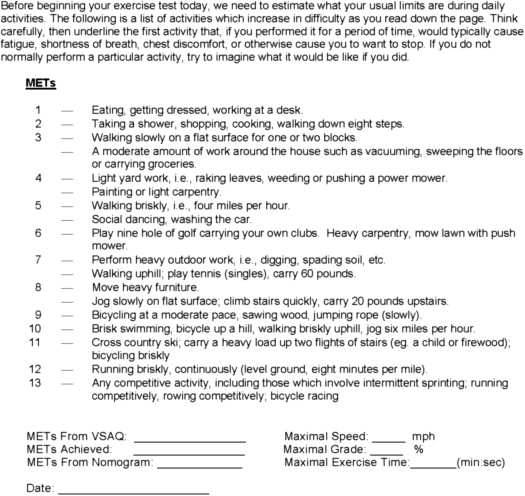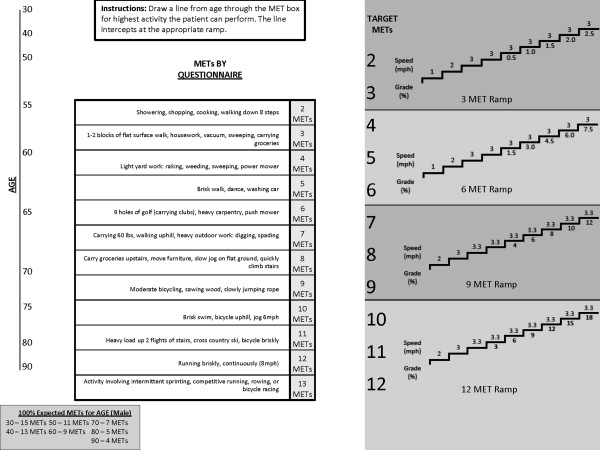Studies performed over the past 2 decades have supported the recommendation that the exercise test protocol be individualized and that a targeted duration of 8 to 12 minutes is optimal. However, this is not always implemented clinically because of the complication of having to choose a specific ramp to match a patient. We present a simple nomogram based on a questionnaire to choose 1 of 4 possible ramp protocols that provide individualized ramp rates for subjects undergoing clinical exercise testing.
Despite considerable advances in diagnostic imaging technologies, expert panels have recommended that the standard electrocardiographic exercise test should remain the first choice for evaluating patients suspected of having coronary disease. Studies performed over the past 2 decades have given rise to the recommendation in exercise testing guidelines that the exercise test protocol be individualized and that a targeted duration of 8 to 12 minutes is optimal. Ramp testing has become preferred because it facilitates individualization of the exercise protocol. This is possible because the increase in external work (speed and grade or resistance) occurs in a constant and continuous fashion, and the rate of increase in work (ramp rate) can be individualized throughout a wide range of exercise capacities. The individualized approach to the exercise test requires an estimate of exercise capacity before the test such that the patient’s limits can be targeted to achieve appropriate test duration. Stated differently, the ramp rate (rate of change in speed and grade) must be individualized for the patient so that the duration is not too short or too long. Self-administered symptom questionnaires have been used for this purpose because they provide a simple method for providing such estimates. The Veterans Specific Activity Questionnaire (VSAQ) is a 13-item symptom questionnaire given before an exercise test that is designed to predict a patient’s peak MET level. The VSAQ has been validated worldwide and has been translated into several languages. In the present report, we present a nomogram designed to simplify the use of ramping in clinical practice using the VSAQ.
Methods
The original VSAQ is presented in Figure 1 . The nomogram was developed by determining predictors of exercise capacity from 212 patients, using the VSAQ along with clinical and demographic data as independent variables. Because age and response to the VSAQ were the strongest determinants of subsequent exercise capacity, they were incorporated into a nomogram. Treadmill ramp performance was based on the age of patients and their response to the VSAQ using a regression equation. The equation for predicting achieved METs on the treadmill test was [4.7 + 0.97 (VSAQ score) − 0.06 (age)]. The formula yielded a multiple regression coefficient of 0.82 (SEE 1.43; p <0.001).

For the simplified VSAQ, in Figure 2 , we used this regression formula to create a more generalized nomogram for 4 categories (<3 METs, 4 to 6 METs, 7 to 9 METs, and 10 to 12 METs). Choosing the appropriate ramp rate is based on a line drawn between the patient’s age, through the corresponding MET value for the patient’s VSAQ score, and the ramp protocol chart. This provides the appropriate treadmill ramp protocol to use for a given patient. Although the stages in Figure 2 are 1 minute in duration for simplicity, shorter more frequent stages are more appropriate to achieve true “ramping” (i.e., more linear changes in work rate) if the treadmill or cycle ergometer controller permits.

Discussion
The VSAQ was developed as a method to individualize the increase in work rate for clinical exercise testing, in accordance with exercise testing guidelines published by various expert panels. For nearly 20 years, the VSAQ has lent itself ideally to ramp testing, which permits the operator to select a ramp rate that suits the patient being tested. Immediately before undergoing exercise testing, the VSAQ is given to each patient; the administration of the VSAQ is conducted in the form of a short interview. The VSAQ consists of a list of activities presented in progressive order according to METs ( Figure 1 ). Patients are instructed to determine which activities typically cause fatigue, shortness of breath, chest discomfort, or claudication pain during daily activities. The MET values associated with each activity are derived from various sources and in general agree with the American College of Sports Medicine Compendium of Physical Activities.
Performing the test requires the estimation of exercise capacity based on the VSAQ, choosing the peak speed for a given patient (typically 3.0 mph but may range from 2.0 to 4.0 mph, depending on a given patient’s stride length, fitness, and familiarity with treadmill walking), and a test duration (typically 10 minutes, in accordance with exercise testing guidelines). The ramp rate (rate of change in speed and grade) is then incremented. Most current treadmill or cycle ergometer controllers have software that does this automatically.
Although several advantages of ramp testing have been described in recent years, the most fundamental is that it yields a linear pattern of increase in oxygen uptake (VO 2 ), such that the range of metabolic capacity is distributed evenly over an appropriate duration (e.g., 8 to 12 minutes). By avoiding large and unequal increments in work, there is an improved ability to predict oxygen uptake, reach a greater exercise tolerance, and more uniform hemodynamic and gas exchange responses to exercise compared with traditional staged protocols. Other suggested advantages to ramp testing include better diagnostic characteristics and improvements in the interpretation of ventilatory gas exchange responses (including submaximal responses, the VE/VCO 2 slope, and the ventilatory threshold), estimating prognosis, and developing an exercise prescription.
Ramp protocols or ramp-type approaches have been widely recommended for over 2 decades, and the modified VSAQ facilitates the application of ramp testing. Although this approach is directed toward the application of the ramp protocol, it can be applied to other incremental protocols as well, with the goal of individualizing the exercise test in accordance with exercise testing guidelines.
Stay updated, free articles. Join our Telegram channel

Full access? Get Clinical Tree


